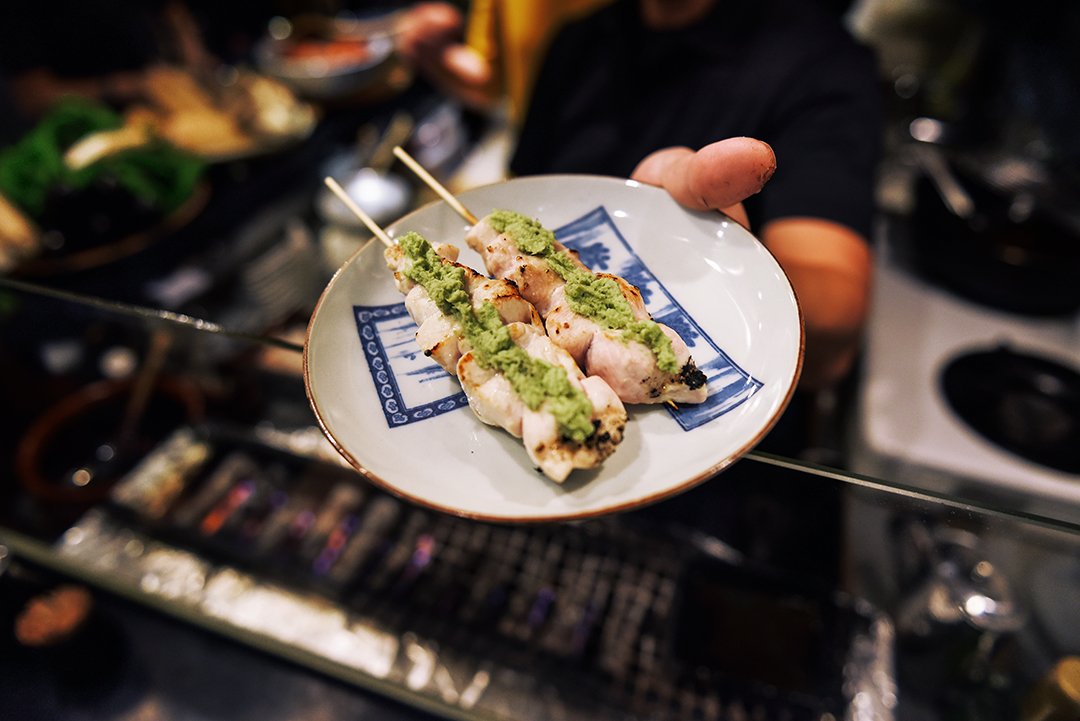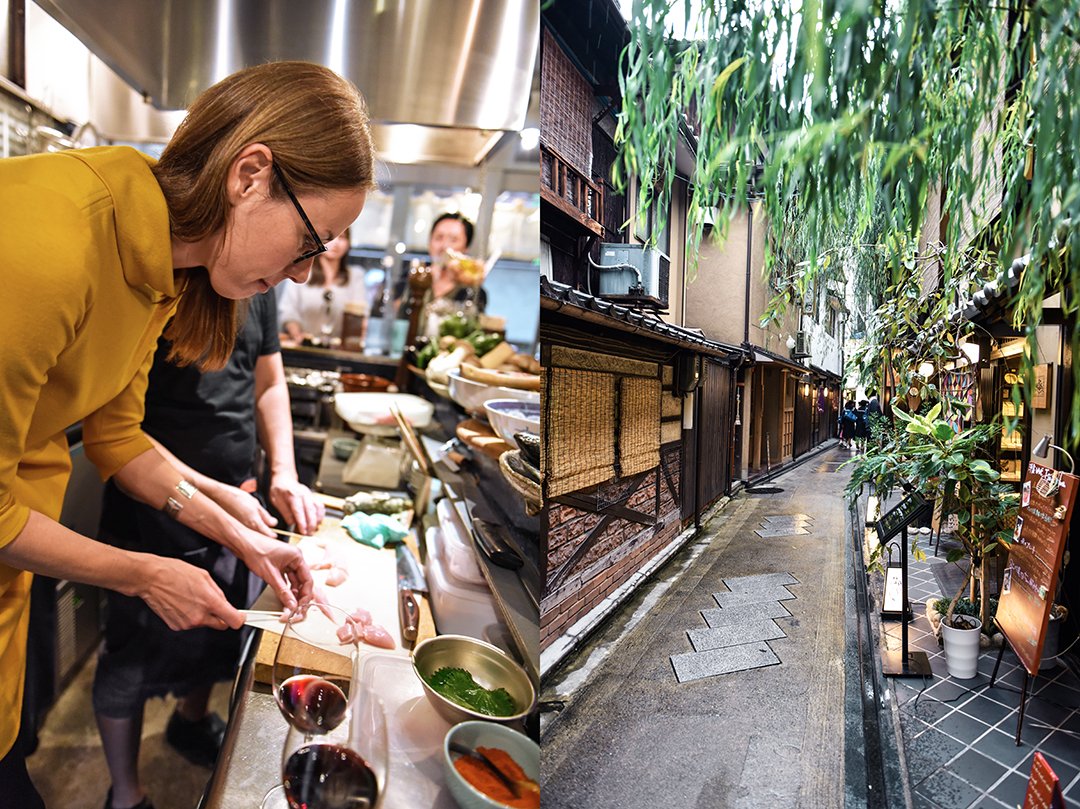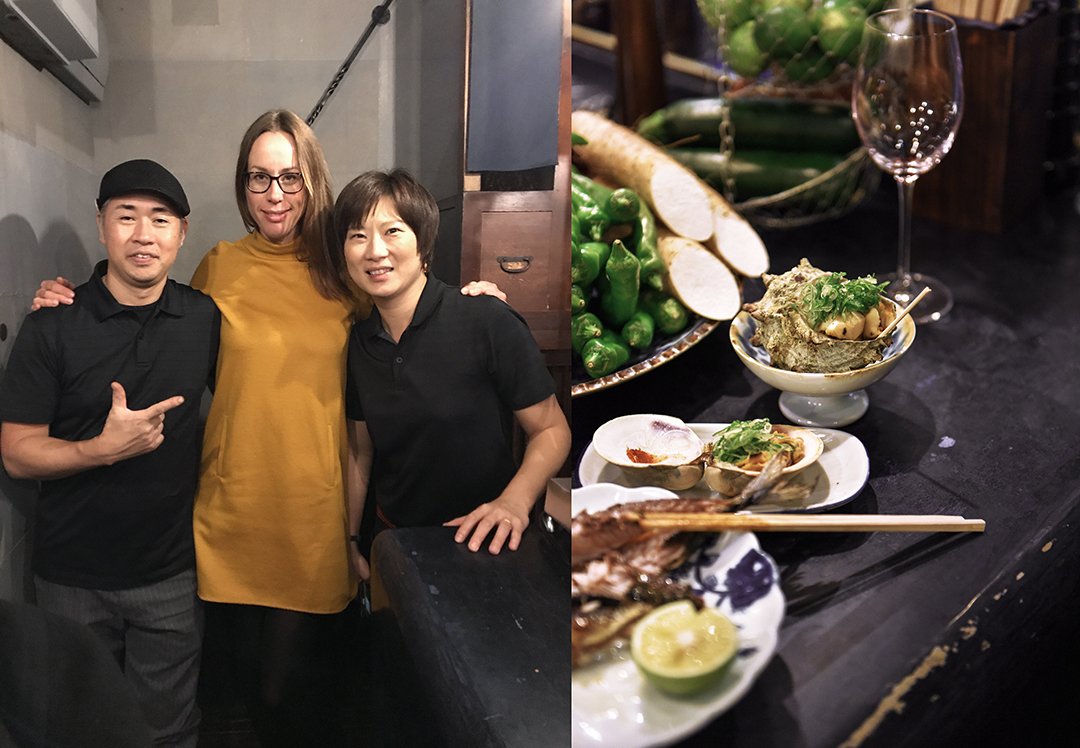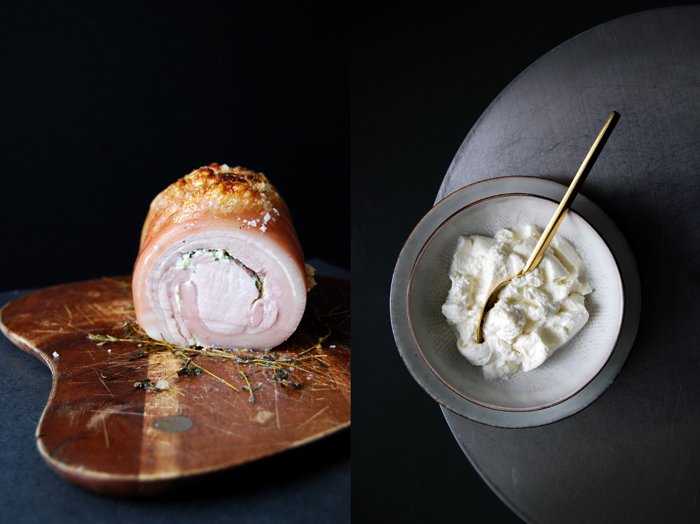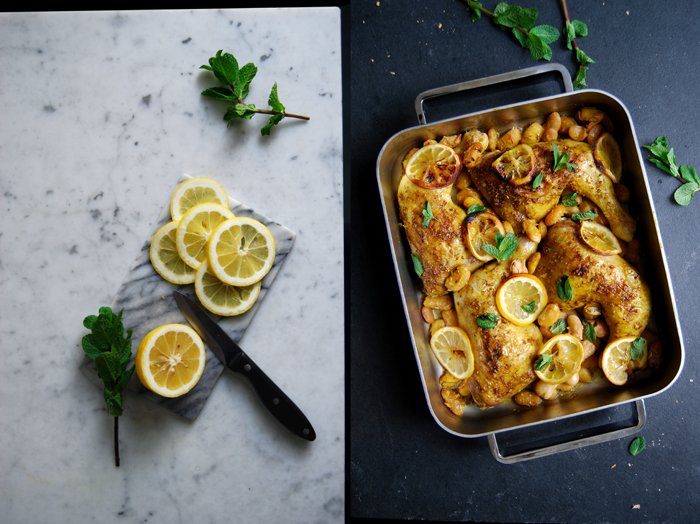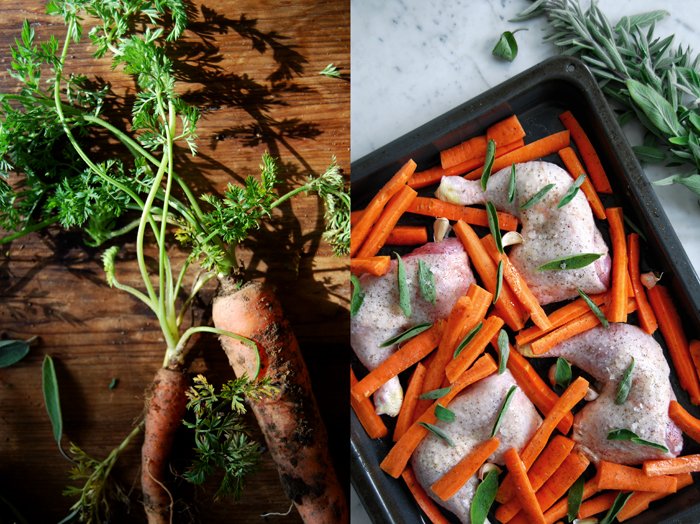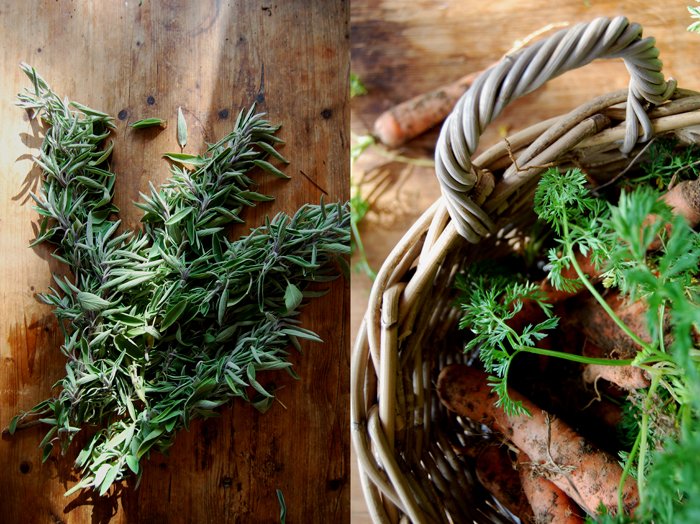Meet In Your Kitchen | Taka's Japanese-Italian Fusion Cuisine in Kyoto
Eating at Taka's restaurant in Kyoto feels like having a Japanese feast celebrated with your exuberant Italian family. The place is tiny, it's in a narrow old house tucked into a small secluded alley right in the old city's busy heart. An L-shaped counter separates the celebrated chef from his hungry guests, however, there's a lot of interaction going on. The kitchen is open so you can follow all of Chef Nishimura Takashi's steps, how he grinds the fresh wasabi in smooth circles on a shark skin-covered wooden board (the only proper way to grind the green root as I've learned). The charming chef looks like a versed dancer. He quickly grabs pots and spices from the shelves behind him and then, in the next second, turns around to briefly cook tender chicken sashimi (see the recipe below) in the flames of his little grill; or local beef, or mackerel until it has a crispy golden crust all around. The restaurant's menu is a revelation, sea urchin spinach and tempura lotus root sprinkled with matcha salt are simply divine. Sitting at the counter and enjoying Japanese tapas is a feast in its true meaning: You eat, drink, and share delicious treats with old and new friends.
Kyoto born Chef Taka has lived and worked abroad for years, in Australia, Denmark, and in Italy, in Milan, where he also met his wife Akane. Before they opened their gastro pub in Kyoto, Taka worked at Armani's Nobu Milano restaurant for 10 years, which explains why you can also find wonderful organic Tuscan wines and Mediterranean style dishes on the menu, like the fruitiest eggplant slowly cooked in an aromatic tomato sauce. It's the combination of these two worlds that makes the couple's restaurant in Kyoto so exciting, yet at the same time it's so relaxed. It's the kind of place where you end up chatting with the guests sitting next to you, exchanging stories and dishes, saying Kanpai (cheers) with a glass of red wine in your hand or ending the night with an extensive sake tasting involving everyone in the room.
Taka and Akane love food and people, the people who visit them, their guests, and the people they work with, their kitchen team, but also the suppliers who deliver fresh produce and products of the best quality to this tiny kitchen in the heart of Kyoto. The couple knows all of them personally, they've been working with them for years, most of them coming from the area. Having lived and worked in two food meccas in the world, Italy and Japan, the restaurateurs say that they can only create fantastic food, if the ingredients are perfect, vegetables picked at the peak of their season, the meat coming from animals that were bred and fed with care and respect. Japanese and Italian cooking is similar, both cuisines are very simple and focus on good ingredients, and at Taka, they create a very complete fusion.
In the next months, I’ll share many Meet In Your Kitchen features with you that took me to California, Italy, France, and Japan. Thanks to Zwilling for sponsoring these features for our culinary trip around the world!
Grilled Chicken Sashimi with Wasabi
By Taka Nishimura
Chef Taka uses chicken of outstanding quality, he knows the farmer and he can guarantee the meat's quality and freshness, which is why he can serve this dish almost raw. However, it is highly recommended to cook chicken until it's cooked through.
Serves 2
4 skinless, boneless chicken breast tenderloins, sashimi grade
Freshly grated wasabi
Rock salt
4 wooden skewers
Heat the BBQ.
Cut each chicken tenderloin into 6 pieces and thread onto the 4 skewers. Grill lightly until just done.
Spread the chicken with freshly grated (!) wasabi and season with salt to taste. Serve immediately.
Could you introduce yourself?
My name is Nishimura Takashi. I lived in Italy for a long time, about 15 years. I worked in a world-renowned restaurant called NOBU. And about 2 years ago I moved back to Kyoto, my hometown, to open this small restaurant.
What is your most cherished childhood memory connected to the kitchen?
A cherished memory would have to be, when I was a child, all I watched were shows about food on TV. All I watched were cooking TV shows, and I remember cooking a lot with my siblings when we were small. No one in my family is a cook, I'm the only one who followed a career as a chef. And it was when I was in primary school that I decided to become a chef, it was then that I decided to learn how to cook Japanese cuisine.
Why did you decide to move to Italy and work in Italy as a chef?
Well, I had always made Kaiseki cuisine in Kyoto, I trained in Kyoto Kaiseki for about 15 years. And so then, at that time, Kyoto was amazing, it was a narrow entrance into Japanese cuisine. Now foreigners come here to learn how to cook Kaiseki, but it wasn't like that at all back then. So I wondered why? Japanese people go to Italy to study Italian cuisine, and to France to study French cuisine. So I thought, why don't foreigners come to Japan to study Japanese cuisine? I figured that if that was the case than I wanted to go abroad to teach Japanese cuisine, that's what I felt I wanted to do. And I remember feeling that I'd been a chef for 10 years, I'd learnt a lot in that time and wanted to share my knowledge abroad. So I chose somewhere that had similar food. I first chose Italy because I thought they had a simple way of cooking, and ingredients that had a lot of umami, where Japanese cuisine would be accepted by Italian tastes. And then I worked at NOBU in Italy.Now, in the last 10 years, things changed. Many chefs come to Kyoto and Osaka, Tokyo, studying the Japanese style.
What changed over the years?
That was probably because Japanese chefs became more open-minded. I think one reason is that they began to look outside Japan more. Also, famous chefs wanted to learn more about the mentality behind Japanese Kaiseki cuisine and how to make it. Making each course and slowly serving one small plate after another is Japanese Kaiseki's style. That's how you draw people to your restaurant. You're delicate even when you serve the food, there is even a special orientation for each plate.Every country's cuisine is wonderful, but in Japan it's all about the cut. For example, how sashimi is cut, how the vegetables are cut, how the meat is cut. These cuts create an excellent style of cooking, it's Japanese cooking. It's "katsuru" which means "cuts", which is what gives it such a high aesthetic. Even with sashimi the chefs cut them beautifully. It creates a very unique Japanese aesthetic. The kitchen knife cuts amazingly, every day you need to sharpen your knives, and sharpening them is one part of a chef's training, and I think even foreigners now sense this beauty. That's what I think. Vegetables cut straight, how they're beautifully peeled into hexagons, all kinds of shapes, the manual work that goes into it is amazing.
What makes a good knife? What are the important features of a good knife?
Of course how it cuts, the better it cuts the more beautiful the cut is. Also, how it feels when you hold it. You might have the same knife, but their weights can be different. Or there are knives that suit only you, so Japanese chefs will always buy their own knives. There's also a balance to them. And chefs are using them for a long time, for the entire day, so it needs to not get worn out, it needs to not be a burden for chefs that work for a long time. I think all of these things are considered when knives are made, there's a long history for this. Japanese knives are very particular. Fish is fish, vegetables are vegetables, meat is meat, and we divide them as such, but I think a knife that can be used for all of these is amazing.
What is special about Kyoto cuisine compared to other parts of this country?
I'd say how we compose the meal. There are a lot of difficult things about it but the best thing is how you can enjoy it as you like. Next is how the plates match. There are a number of Japanese meals where you look at the plates as you eat, and there are lots of regions that can make great plates. There's also the matter of gathering good ingredients. Of course each region of Japan has its own wonderful ingredients, but among those, you have Kyoto chefs who will search all over the place to find the best ingredients of the season and who will think of their customers’ faces as they make them. That mentality is unbroken, it's passed down from generation to generation, there's always been this fantastic culture. That's why there are so many things that I think are amazing.In Kyoto, it's really easy to distinguish between the 4 seasons. So when autumn comes you can use autumn ingredients and incorporate their beauty into the food. Kyoto chefs understand this sensibility.
How close is the relationship between you and your suppliers?
That's a great question. You can do that really easily in Kyoto. I've been working… since I was young, so I've been working with suppliers since the beginning. There are fishmongers and vegetable suppliers that I've known for over 30 years. People also introduce me to people they know, like butchers. I've used a lot of connections, and I try to use Kyoto wholesalers as much as possible, and I want to use them more. I have my restaurant in Kyoto right now. We say "local produce for local consumption", and it was the same in Italy. There are ingredients specific to regions and I try to incorporate them in my cooking as much as possible. Now I get requests from the Ministry of Agriculture and other chefs help out too. I want to help revitalise the area, so I get introduced to a lot of different people, and I can get hold of good ingredients. That really makes this job easier.
What was your vision for your restaurant?
I wanted a small restaurant where I could be close to customers sitting at the counter, so they're closer to the chef too. That way everyone can enjoy themselves as they eat, that makes the meal even more delicious. That way people's circle of friends could grow too. I want to make a restaurant like that and introduce everyone to it. And if I get any foreign customers, I want to help give them a place where they can make wonderful memories of Kyoto. I really wish from the bottom of my heart that I can help them make memories.
Thank you, Taka and Akane, for creating wonderful food and memories!
My Maltese Winter Sandwich: Pomegranate Chicken, Red Coleslaw & Bacon
We drove down the winding road to the Grand Harbour in Valletta and stopped our cars in front of an old garage. The wooden door must have seen many storms, the green paint faded and the hinges rusted, it's the salt in the air that takes over whatever it gets hold of. Our friends Michelle and Michelangelo came down to the harbour in the cutest Volkswagen beetle the world has ever seen - in baby blue (Michelangelo would correct me and say it's Diamond Blue). Built in 1968, the car only changed owner once, when our friends bought it in 2010 from an elderly lady from the village of Qormi. It was in mint condition despite its 110,000 original kilometres. The previous owner's name was Teresa and she became the eponym of our friend's little love bug, since then, the beetle is affectionately called Terez.
Terez - and her original 1300cc single port engine, a fact that Michelangelo points out with pride in his voice - has seen a lot since she found her new owner: four overland trips, the latest being our friend's honeymoon trip last summer. The three of them (including Terez) attended the Le Bug Show 2016 in Spa and crossed half of Europe to get there. Malta, Sicily, France, Switzerland, Belgium, and Germany added 5,400 kilometres to the tachometer and seemed to have made the bond between the car and its owners even stronger.
Every car needs a check up once in a while, especially when it's nearly 50 years old, and to make it a little more fun, I joined my friends and brought some food and my camera. While Michelangelo laid hands on the tires, I kept mine busy preparing sandwiches for all of us. It's the peak of winter, a time of year when I usually have to confront Berlin's seemingly endless, yawning grey sky for weeks and months, but here in Malta I'm spoilt with sunshine and vibrant colours. This inspired me to come up with a snack as fresh and bright as the Mediterranean world around me. It's a chicken sandwich, the meat tender and thinly sliced, with purple coleslaw and orange wedges, sparkling pomegranate seeds (some of which I turned into a sticky syrup), crunchy bacon bites, and pungent green onions. The composition is rather difficult to eat, but trust me, the pleasure that you'll feel when you taste it, is absolutely worth it. And the solution is simple, just squeeze it until the sticky juices run out of the sandwich and soak the soft bread - it's a heavenly mess.
Thank you Michelle, Michelangelo, and Terez for a wonderful morning in Valletta!
For more delicious recipes and kitchen inspiration, visit Volkswagen's Pinterest community board Food Bloggers for Volkswagen.
My Maltese Winter Sandwich: Pomegranate Chicken, Red Coleslaw, Orange and Bacon
Makes 6 sandwiches
For the coleslaw
cored red cabbage, cut into thin strips, about 230g / 1/2 pound
fine sea salt
yoghurt 5-6 tablespoons
freshly squeezed orange juice
ground pepper
For the pomegranate syrup
pomegranate juice 180ml / 3/4 cup
granulated sugar 4 1/2 tablespoons
For the sandwich
olive oil
chicken breast 400g / 14 ounces
fine sea salt
ground pepper
bacon 6 slices
lettuce leaves 6
white buns (or ciabatta cut into buns), cut in half, 6
oranges, peeled and cut into filets, 1-2
the seeds of 1 pomegranate
green onions, the green part cut into thin slices, 1
freshly grated orange zest, about 1 tablespoon
For the coleslaw, in a large bowl, mix the cabbage and 1/2 teaspoon of salt and, using your fingers, rub the salt into the cabbage. Let it sit for about 15-20 minutes. Add the yoghurt and orange juice, mix well, and season with salt and pepper to taste.
Preheat the oven to 200°C / 400°F.
For the pomegranate syrup, in a saucepan, bring the pomegranate juice and the sugar to the boil and cook over medium-high heat (it should bubble) for about 7 minutes or until it starts to thicken. Set the syrup aside.
In a heavy pan, heat a splash of olive oil over high heat and cook the chicken breast for a couple minutes on each side until golden, you might have to reduce the heat to medium-high. Season with salt and pepper to taste and transfer the chicken to a baking dish. Roast in the oven for about 8 minutes or until the chicken is cooked through. Check with a skewer, only clear juices should come out. Let the chicken rest in aluminium foil for about 5 minutes. Cut the chicken into slices (about 18 slices for 6 sandwiches).
In a large heavy pan, heat a splash of olive oil and cook the bacon for a few minutes on both sides until golden brown and crisp. Transfer to paper towels, let it cool for a few minutes, then break the bacon into pieces.
Divide the lettuce leaves between the bottoms of the buns and arrange the chicken on top, drizzle with a little of the pomegranate syrup. Spread a heaping tablespoon of coleslaw, 2-3 orange filets, and some pomegranate seeds on top of the chicken. Sprinkle with the sliced green onion, bacon bites, and orange zest, and drizzle with additional pomegranate syrup. Close the bun, squeeze, and enjoy!
7 Meat & Roast recipes to indulge in on Thanksgiving
A meal at a festive table, in the dimmed light of flickering candles, all our loved ones around us, is always a gift, it's a feast of love and sharing. These are very precious memories of our lives, we'll never forget the food we smelled and tasted, the grateful happiness in the eyes of our family and friends, the room filled with music and laughter.
Let's talk about meat and roast recipes to make our Thanksgiving table complete and accompany my 10 pumpkin recipes that I shared with you a couple days ago. I love my juicy Roast Rosemary Lamb or the tender Thyme and Lemon Ricotta stuffed Pork Roll. You can also find a recipe for a delicious German pork roast with crackling in my cookbook, on page 163. Slow roasted duck, preferably cooked together with fruit, will always find a special place in my heart, the meat is so tasty and tender, the skin crisp, it's definitely one of my favourites for a special feast at the table.
Besides the classic roasts, there are other scrumptious recipes that I could indulge in with the greatest pleasure, also on Thanksgiving: Coq au Vin, tiny Lamb Chops with Orange and Herb Crust, or Spice Roast Chicken Legs with Butter Beans.
Click on the titles for the recipes
Roast Chicken with spiced Peaches: (you can replace the peaches with plums)
Honey glazed Chicken and Carrots roasted with Sage
A package filled to the brim with carrots and sage arrived at my door a couple days ago. I opened the box impatiently and when I lifted the cover a cloud of soil and sage aromas filled the room. I removed the top layer of sage leaves, closed my eyes and dug my hands into the greens of 6 pounds of carrots. It felt like standing on a field in the middle of a farm!
The box came from my mother's vegetable garden where she bas been busy with the annual spring chores. I envy her for the fertile patch of earth where she grows all kinds of vegetables in unbelievable quantities, potatoes, beans, carrots, peas, tomatoes, zucchini, leek, celery, lettuce and, of course lots of herbs. Whenever I ask her about her harvest, she tells me about so many different vegetables that I'm sure I forgot to list one or two. The area she chose for her gardening isn't large, it has a slight decline, perfectly aligned facing the South so it's in the the sun all day and the soil is very rich. A couple days ago she called me up to ask if I would like to have some of last year's carrots which had been in the soil all winter but had to make room for the new seeds. She dug pound after pound out of the soil (she was a bit impressed by the amount herself) and now she was looking for thankful recipients. I was glad to be one of them, I didn't even know that one can eat carrots which have been in the ground all winter. To keep them safe and moist on their travel she wrapped them in branches of sage which apparently grow like weeds in her garden. If there is one person who has a green thumb it's definitely my mother!
So the carrots arrived and I had to come up with an idea to use them, a recipe which demands lots of carrots. I didn't make roast chicken legs in a while so a quick decision was made, honey glazed chicken legs and carrots roasted with sage!
Honey glazed Chicken Legs and Carrots roasted with Sage
If you like you can marinate the chicken legs in the honey glaze for an hour (or longer) but season with salt and pepper just before you put them in the oven.
For 4 people you need
chicken legs 4
honey 2 tablespoons
olive oil 5 tablespoons plus a couple tablespoon for the carrots
large carrots, quartered lengthwise, 10
garlic, in their skin, 10 cloves
fresh sage leaves 30 (10 chopped)
salt and pepper
Set the oven to 200°C / 390°F. My oven has a Rotitherm roasting setting which works perfectly for poultry.
Warm the honey in a sauce pan on medium heat until liquid, take off the heat and add the olive oil, whisk till combined. Glaze the chicken legs on all sides with the honey and season with salt and pepper. Place on a baking sheet, add the carrots and garlic and spread the remaining honey over the chicken and vegetables. Pour some more olive oil over the carrots and season them with salt and pepper. Sprinkle with the sage (chopped and leaves) and put 2 of the leaves under each leg. Roast in the oven for 20 minutes or until golden brown. Check with a skewer, only clear juices should come out. Turn the grill on for a couple minutes until the skin starts sizzling and turns dark and crisp.





